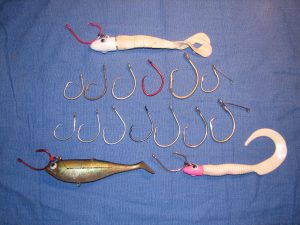Deep-sea fishing is a thrilling experience, often yielding impressive catches like marlin, tuna, and grouper. Among the various tackle choices, the circle hook stands out as a top contender for deep-sea fishing, particularly for those targeting larger species. Understanding when and why to use circle hooks can enhance your fishing success while promoting responsible angling.
Why Choose Circle Hooks?
Circle hooks have a unique design that sets them apart from traditional J-hooks. Their circular shape causes them to rotate in the fish’s mouth, typically hooking securely in the corner of the jaw. This reduces the likelihood of gut-hooking a fish, which can be fatal. For deep-sea fishing, where catch-and-release is common, this feature is invaluable as it significantly increases the survival rates of released fish.
Best Scenarios for Circle Hooks in Deep-Sea Fishing
1. Targeting Large Predatory Fish: When fishing for large predators like marlin, sailfish, or tuna, circle hooks are often preferred. These species tend to take baits deeply, and the self-hooking nature of circle hooks ensures a firm and secure hook-up without requiring a strong, forceful hookset. This makes them ideal for trolling and live baiting, where a smooth, steady application of pressure is more effective than a sharp jerk.
2. Fishing with Live Bait: Circle hooks are especially effective when using live bait in deep-sea fishing. The hook’s design allows the bait to swim more naturally, making it more enticing to predatory fish. Additionally, when the fish strikes, the hook’s rotation as the fish swims away will often result in a solid jaw hook, minimizing injury to the fish and improving catch rates.

3. Compliance with Regulations: Many deep-sea fishing locations, especially those with strict conservation measures, mandate the use of circle hooks. For example, when fishing for certain species of billfish or in areas like the Gulf of Mexico, circle hooks are required by law when using natural bait. These regulations aim to promote sustainable fishing practices, as circle hooks are less likely to cause fatal injuries to fish that are not kept.
4. Catch and Release: For anglers practicing catch and release, circle hooks are the go-to option. Their design ensures the fish is hooked in the mouth, reducing injury and making it easier to release the fish unharmed. This is crucial in deep-sea environments, where many species are released due to size limits or conservation efforts.
In deep-sea fishing, the decision to use circle hooks can significantly impact both your success rate and the health of the fish population. Whether targeting large predatory fish, using live bait, or complying with regulations, circle hooks are a smart choice. They offer a combination of effectiveness and conservation, making them a staple in any deep-sea angler’s tackle box.





